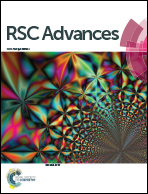An ultrasensitive colorimetric aptasensor for ATP based on peptide/Au nanocomposites and hemin–G-quadruplex DNAzyme†
Abstract
A peptide nanosphere-based colorimetric aptasensor for the ultrasensitive detection of adenosine triphosphate (ATP) has been fabricated. By conjugating gold nanoparticles (AuNPs) onto peptide nanospheres (PNS), the PNS/AuNPs nanocomposite was obtained and used as a carrier for single-strand ATP aptamer (S1) and signaling DNAzyme sequence. In the presence of ATP, the nucleic acids decorated PNS/AuNPs could immobilize to a 96-well plate which was modified with another single-strand ATP aptamer (S2) DNA. Then, upon addition of K+ and hemin, the designed signaling DNAzyme sequence on PNS/AuNPs could form the hemin–G-quadruplex DNAzyme and catalyze the conversion of TMB to coloured TMB2+. The colorimetric aptasensor adopting PNS/AuNPs nanocomposites as signal enhancers possesses much higher sensitivity towards ATP compared with the conventional AuNPs-based aptasensors. The PNS/AuNPs-based sensor is available for sensitively detecting ATP in a concentration range of 0.01–1 nM with a detection limit of 1.35 pM. Moreover, the constructed aptasensor displayed excellent selectivity for ATP over other analogues such as GTP, CTP and UTP. The proposed strategy for the construction of an aptasensor based on nanocomposites has great potential to become a universal technique for developing various aptasensors by using different aptamers.


 Please wait while we load your content...
Please wait while we load your content...